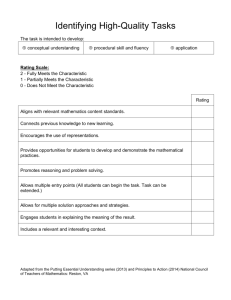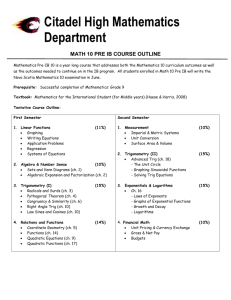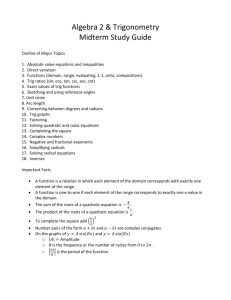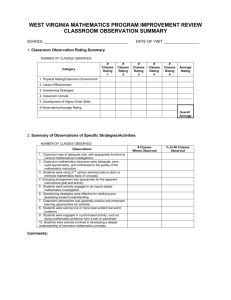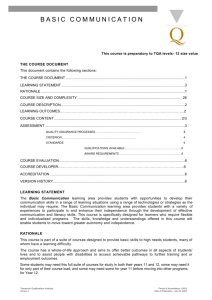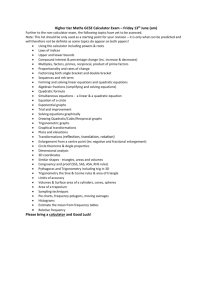The cOURSE document - Tasmanian Assessment, Standards and
advertisement
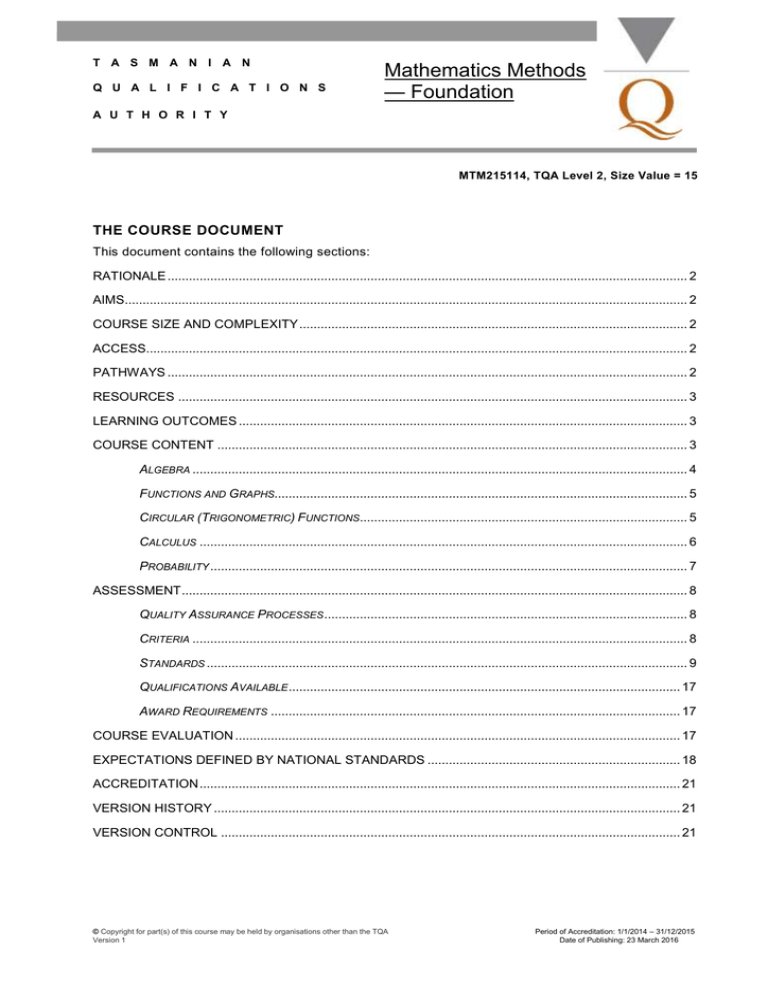
T A S M A N I A N Q U A L I F I C A T I O N S Mathematics Methods — Foundation A U T H O R I T Y MTM215114, TQA Level 2, Size Value = 15 THE COURSE DOCUMENT This document contains the following sections: RATIONALE .................................................................................................................................................. 2 AIMS.............................................................................................................................................................. 2 COURSE SIZE AND COMPLEXITY ............................................................................................................. 2 ACCESS........................................................................................................................................................ 2 PATHWAYS .................................................................................................................................................. 2 RESOURCES ............................................................................................................................................... 3 LEARNING OUTCOMES .............................................................................................................................. 3 COURSE CONTENT .................................................................................................................................... 3 ALGEBRA ........................................................................................................................................... 4 FUNCTIONS AND GRAPHS.................................................................................................................... 5 CIRCULAR (TRIGONOMETRIC) FUNCTIONS............................................................................................ 5 CALCULUS ......................................................................................................................................... 6 PROBABILITY ...................................................................................................................................... 7 ASSESSMENT .............................................................................................................................................. 8 QUALITY ASSURANCE PROCESSES ...................................................................................................... 8 CRITERIA ........................................................................................................................................... 8 STANDARDS ....................................................................................................................................... 9 QUALIFICATIONS AVAILABLE .............................................................................................................. 17 AWARD REQUIREMENTS ................................................................................................................... 17 COURSE EVALUATION ............................................................................................................................. 17 EXPECTATIONS DEFINED BY NATIONAL STANDARDS ....................................................................... 18 ACCREDITATION ....................................................................................................................................... 21 VERSION HISTORY ................................................................................................................................... 21 VERSION CONTROL ................................................................................................................................. 21 © Copyright for part(s) of this course may be held by organisations other than the TQA Version 1 Period of Accreditation: 1/1/2014 – 31/12/2015 Date of Publishing: 23 March 2016 2 Mathematics Methods - Foundation TQA Level 2 RATIONALE Mathematics is the study of order, relation and pattern. From its origins in counting and measuring it has evolved in highly sophisticated and elegant ways to become the language now used to describe much of the modern world. Mathematics is also concerned with collecting, analysing, modelling and interpreting data in order to investigate and understand real-world phenomena and solve problems in context. Mathematics provides a framework for thinking and a means of communication that is powerful, logical, concise and precise. It impacts upon the daily life of people everywhere and helps them to understand the world in which they live and work. Mathematics Methods - Foundation provides the study of algebra, functions and their graphs, calculus and probability. These are necessary prerequisites for the study of Mathematics Methods, TQA level 3, in which the major themes are calculus and statistics. For these reasons this subject provides a foundation for study of Mathematical Methods, TQA level 3, and disciplines in which mathematics has an important role, including engineering, the sciences, economics, health and social sciences. AIMS Mathematics Methods - Foundation aims to develop students’: understanding of concepts and techniques drawn from algebra, the study of functions, calculus and probability ability to solve applied problems using concepts and techniques drawn from algebra, functions, calculus and probability reasoning in mathematical contexts and interpretation of mathematical information including ascertaining the reasonableness of solutions to problems capacity to communicate in a concise and systematic manner using appropriate mathematical and statistical language capacity to choose and use technology appropriately and efficiently. COURSE SIZE AND COMPLEXITY This course has a complexity level of TQA level 2. At TQA level 2, the student is expected to carry out tasks and activities that involve a range of knowledge and skills, including some basic theoretical and/or technical knowledge and skills. Limited judgment is required, such as making an appropriate selection from a range of given rules, guidelines or procedures. VET competencies at this level are often those characteristic of an AQF Certificate II. This course has a size value of 15. ACCESS It is recommended that students attempting this course will have previously achieved at least a Grade 10 ‘B’ in Australian Curriculum: Mathematics, or are concurrently studying Grade 10 Australian Curriculum: Mathematics. PATHWAYS The subject Mathematics Methods - Foundation is designed for students whose future pathways may involve the study of further secondary mathematics or a range of disciplines at the tertiary level. It is highly recommended as a foundation course for the study of Mathematics Methods, TQA level 3. Tasmanian Qualifications Authority Version 1 Period of Accreditation: 1/1/2014 – 31/12/2015 Date of Publishing: 23 March 2016 3 Mathematics Methods - Foundation TQA Level 2 RESOURCES Programs of study derived from this course need to embrace the range of technological developments that have occurred in relation to mathematics teaching and learning. Students should have access to graphics calculators and become proficient in their use. Graphics calculators can be used in all aspects of this course in the development of concepts and as a tool for solving problems. Where feasible, students should have some experience with CAS technology. Refer also to the current TQA Calculator Policy that applies to TQA level 3 courses, available at http://www.tqa.tas.gov.au/0021. The use of computers is recommended as an aid to students’ learning and mathematical development. A range of packages is appropriate and, in particular, spreadsheets should be used. LEARNING OUTCOMES On successful completion of this course, students will: have personal skills to organise and complete activities including practical tasks understand the concepts and techniques in algebra, graphs, functions, calculus and probability solve problems using algebra, graphs, functions, calculus and probability apply reasoning skills in the context of algebra, graphs, functions, calculus and probability interpret and evaluate mathematical information and ascertain the reasonableness of solutions to problems communicate their arguments and strategies when solving problems choose and use technology appropriately and efficiently. COURSE CONTENT For the content areas of Mathematics Methods – Foundation, the proficiency strands – Understanding; Fluency; Problem Solving; and Reasoning – build on students’ learning in F-10 Australian Curriculum: Mathematics. Each of these proficiencies is essential, and all are mutually reinforcing. They are still very much applicable and should be inherent in the study of five (5) areas of mathematics: Algebra Functions and graphs Circular (trigonometric) functions Calculus Probability. Each area of study is compulsory, however the order of delivery is not prescribed. These mathematics areas relate to Criteria 4 – 8. Criteria 1 – 3 apply to all five areas of mathematics. Tasmanian Qualifications Authority Version 1 Period of Accreditation: 1/1/2014 – 31/12/2015 Date of Publishing: 23 March 2016 4 Mathematics Methods - Foundation TQA Level 2 ALGEBRA Students will be introduced to relevant conventions relating to algebraic language and notation. They will further develop their skills in the algebraic manipulation of simple polynomial functions (linear, quadratic and cubic) in the context of their function study work. This area of study will include: substitution in and rearrangement of formulae identification of key features of polynomials: variables, coefficients, degree and so on the use of notation expansion of quadratics and cubics from factors expansion of a binomial expression (ax + b )n using Pascal’s triangle factorisation: ; substitution and evaluation of where a is real o connections between factors, roots, zeroes and corresponding graphs of functions o quadratic trinomials o factor theorem limited to cubics with at least one factor of the form integer o sum and difference of cubes where a is an quadratic equations: obtaining rational solutions or approximations to solutions by systematic trial and error, by graphing, by simple iteration, obtaining rational and irrational solutions by completion of the square (for cases where the coefficient of formula is 1 only) and by the quadratic use of the discriminant to determine if a quadratic has real factors completion of the square method for finding maximum or minimum values of quadratic functions and in justifying the proof of the quadratic formula cubic equations and their solution by any of the following methods: o graphing (including cases that do not have three solutions) o systematic trial and error o algebraic methods: for example, factorisation of cubics that have at least one integer zero o solution of two linear simultaneous equations, and one linear and one quadratic equation by numerical, graphical or algebraic methods. Tasmanian Qualifications Authority Version 1 Period of Accreditation: 1/1/2014 – 31/12/2015 Date of Publishing: 23 March 2016 5 Mathematics Methods - Foundation TQA Level 2 FUNCTIONS AND GRAPHS Students will develop their understanding of the behaviour of a range of functions by sketching and analysing polynomials of degree no higher than three and exponential and logarithmic functions. This area of study will include: finding equations of straight lines from given information gradients of parallel and perpendicular lines graphs and their use to express and interpret relationships sketch graphs of straight lines, quadratics and cubics (including the use of simple transformations) informal treatment and use of terminology, domain, range, function and relation revision of basic index laws extended to negative and rational indices omitting extensive algebraic manipulation but including simple equations. graphs of (a>0 aR) [including the use of simple transformations] and solving exponential equations related to these graphs by calculator or by graphical methods definition of logarithm (base a) and the relationship between index and log statements graph of (including the use of simple transformations) using calculator-generated values and the relationship of the graph to that of relationship ; informal discussion of their inverse simple applications of exponential functions such as growth and decay, compound interest, inflation and depreciation. CIRCULAR (TRIGONOMETRIC) FUNCTIONS Students will develop their understanding of a range of circular (trigonometric) functions. This area of study will include: definition of a radian, and conversion between radians and degrees; unit circle definitions of sine, cosine and tangent and properties that arise from these definitions o the range of sine and cosine values, o the relationship o basic symmetry properties such as , basic sine, cosine and tangent graphs (without transformations). Tasmanian Qualifications Authority Version 1 Period of Accreditation: 1/1/2014 – 31/12/2015 Date of Publishing: 23 March 2016 6 Mathematics Methods - Foundation TQA Level 2 CALCULUS Students will develop an intuitive understanding of instantaneous rate of change through familiar situations, and through a graphical and numerical approach to the measurement of constant, average and instantaneous rates of change. This area of study progresses to differentiation of polynomials of degree no higher than three. Extension to maximising problems, where the required expression is not given, is not required. This area of study will include: concepts of rates of change o practical examples of instantaneous rates of change o practical examples of average rates of change rate of change of a linear function: use of gradient as a measure of rate of change graphs and the interpretation to rates of change, for example, where the rate of change is positive, negative or zero average rate of change: use of the gradient of a chord of a graph to describe average rate of change of with respect to x, over a given interval instantaneous rates of change o defining the (instantaneous) rate of change as given by the gradient of the graph at a given point o linear functions as examples of constant rate of change o quadratics and cubic functions as examples of variable rates of change relating the gradient function to features of the original function applying rates of change in motion graphs o construction and interpretation of displacement-time and velocity-time graphs o informal treatment of the relationship between displacement-time and velocity-time graphs the measurement of rates of change of polynomial functions: numerical approximations to the gradient at a point, leading to an informal treatment of limits graphical or numerical approaches to find the gradient function for graphical or numerical approaches to justify rules for finding the gradient functions of simple polynomial functions the derivative as the gradient of the graph at a point and its representation by a gradient function notation for derivatives: derivatives of simple polynomials and functions with rational or negative powers by rule the use of the derivative to find relative maximum and minimum points of quadratic and cubic functions. Tasmanian Qualifications Authority Version 1 Period of Accreditation: 1/1/2014 – 31/12/2015 Date of Publishing: 23 March 2016 7 Mathematics Methods - Foundation TQA Level 2 PROBABILITY Students will develop counting techniques required for the calculation of probabilities and gain an understanding of the related concepts of conditional and independent events. This area of study will include: random experiments, events and sample spaces probability as an expression of long run proportion probability of simple and compound events Venn diagrams, probability tables and tree diagrams the addition law of probabilities simple complementary events conditional probability and independence; the multiplication rule for independent events permutations: concept of ordered samples combinations: concept of unordered samples Tasmanian Qualifications Authority Version 1 . Period of Accreditation: 1/1/2014 – 31/12/2015 Date of Publishing: 23 March 2016 8 Mathematics Methods - Foundation TQA Level 2 ASSESSMENT Criterion-based assessment is a form of outcomes assessment that identifies the extent of student achievement at an appropriate end-point of study. Although assessment – as part of the learning program - is continuous, much of it is formative, and is done to help students identify what they need to do to attain the maximum benefit from their study of the course. Therefore, assessment for summative reporting to the Tasmanian Qualifications Authority should focus on what both teacher and student understand to reflect end-point achievement. The standard of achievement each student attains on each criterion is recorded as a rating ‘A’, ‘B’, or ‘C’, according to the outcomes specified in the standards section of the course. A ‘t’ notation must be used where a student demonstrates any achievement against a criterion less than the standard specified for the ‘C’ rating. A ‘z’ notation is to be used where a student provides no evidence of achievement at all. Providers offering this course must participate in quality assurance processes specified by the Tasmanian Qualifications Authority to ensure provider validity and comparability of standards across all awards. Further information on quality assurance processes, as well as on assessment, is available in the TQA Senior Secondary Handbook or on the website at http://www.tqa.tas.gov.au. Internal assessment of all criteria will be made by the provider. Providers will report the student’s rating for each criterion to the Tasmanian Qualifications Authority. QUALITY ASSURANCE PROCESSES The following process will be facilitated by the TQA to ensure there is: a match between the standards of achievement specified in the course and the skills and knowledge demonstrated by students community confidence in the integrity and meaning of the qualification. Process: Course providers are required to administer and assess a TQA common assessment task to all students undertaking the course. Each student’s result on the task will have a significant influence on the student’s final award. Results and samples of completed test will be forwarded to the Authority. The Authority gives course providers feedback about any systematic differences in the relationship of their final awards and the results on the common assessment task and, where appropriate, seeks further evidence through audit and requires corrective action in the future. CRITERIA The assessment for Mathematics Methods – Foundation will be based on the degree to which a student can: 1. communicate mathematical ideas and information 2. analysis: demonstrate mathematical reasoning, analysis and strategy in problem solving situations 3. plan, organise and complete mathematical tasks 4. manipulate algebraic expressions and solve equations 5. demonstrate an understanding of linear, quadratic and cubic functions 6. demonstrate an understanding of logarithmic, exponential and trigonometric functions 7. use differential calculus in the study of functions 8. demonstrate an understanding of experimental and theoretical probabilities. Tasmanian Qualifications Authority Version 1 Period of Accreditation: 1/1/2014 – 31/12/2015 Date of Publishing: 23 March 2016 9 Mathematics Methods - Foundation TQA Level 2 STANDARDS CRITERION 1 COMMUNICATE MATHEMATICAL IDEAS AND INFORMATION Rating ‘C’ A student: presents work that shows some of the mathematical processes that have been followed between question and answer uses mathematical conventions and symbols correctly. There may be some errors or omissions in doing so presents work with the final answer apparent uses correct units and sometimes includes them in an answer presents tables, graphs and diagrams that include some suitable annotations adds a diagram to a solution as directed. Rating ‘B’ A student: presents work that conveys a line of reasoning that has been followed between question and answer generally presents work that follows mathematical conventions, and generally uses mathematical symbols correctly presents work with the final answer clearly identified generally presents the final answer with correct units as required presents detailed tables, graphs and diagrams that convey clear meaning adds a diagram to illustrate a solution. Rating ‘A’ A student: presents work that conveys a logical line of reasoning that has been followed between question and answer consistently presents work that follows mathematical conventions, and consistently uses mathematical symbols correctly presents work with the final answer clearly identified, and articulated in terms of the question as required consistently presents the final answer with correct units as required presents detailed tables, graphs and diagrams that convey accurate meaning and precise information adds a detailed diagram to illustrate and explain a solution. Tasmanian Qualifications Authority Version 1 Period of Accreditation: 1/1/2014 – 31/12/2015 Date of Publishing: 23 March 2016 10 Mathematics Methods - Foundation TQA Level 2 CRITERION 2 ANALYSIS: DEMONSTRATE MATHEMATICAL REASONING, ANALYSIS AND STRATEGY IN PROBLEM SOLVING SITUATIONS Rating ‘C’ A student: identifies an appropriate strategy to solve routine problems describes solutions to routine problems describes the appropriateness of results of calculations identifies limitations of simple models uses calculator techniques to solve routine problems. Rating ‘B’ A student: selects and applies an appropriate strategy to solve routine problems interprets solutions to routine and simple non-routine problems describes the reasonableness of the results and solutions to routine problems identifies and describes the limitations of familiar models chooses to use calculator techniques when appropriate, to solve routine problems. Rating ‘A’ A student: selects and applies an appropriate strategy, where several may exist, to solve routine and nonroutine problems interprets solutions to routine and non-routine problems describes the reasonableness of results and solutions to routine and non-routine problems identifies and describes the limitations of familiar and more complex models explores calculator techniques in familiar and unfamiliar contexts. Tasmanian Qualifications Authority Version 1 Period of Accreditation: 1/1/2014 – 31/12/2015 Date of Publishing: 23 March 2016 11 Mathematics Methods - Foundation TQA Level 2 CRITERION 3 PLAN, ORGANISE AND COMPLETE MATHEMATICAL TASKS Rating ‘C’ A student: uses planning tools, with prompting, to achieve objectives within proposed times divides a task into sub-tasks as directed uses given strategies and formulae to successfully complete straight forward problems monitors progress towards meeting goals and timelines meets specified timelines and addresses most elements of the required task. Rating ‘B’ A student: uses planning tools to achieve objectives within proposed times divides a task into sub-tasks selects from a range of strategies and formulae to successfully complete straight forward problems monitors progress towards meeting goals and timelines meets specified timelines and addresses required task elements. Rating ‘A’ A student: uses planning tools and strategies to achieve and manage activities within proposed times divides a task into appropriate sub-tasks selects strategies and formulae to successfully complete complex problems monitors and analyses progress towards meeting goals and timelines, and plans future actions meets specified timelines and addresses all required elements of the task, mostly with a high degree of accuracy. Tasmanian Qualifications Authority Version 1 Period of Accreditation: 1/1/2014 – 31/12/2015 Date of Publishing: 23 March 2016 12 Mathematics Methods - Foundation TQA Level 2 CRITERION 4 MANIPULATE ALGEBRAIC EXPRESSIONS AND SOLVE EQUATIONS Rating ‘C’ A student: expands quadratic and cubic expressions from factors expands simple binomial expressions using Pascal’s triangle, for example, factorises algebraic expressions involving common factors, difference of squares or quadratics solves simultaneous equations involving two linear functions completes the square in a quadratic expression where the coefficient of the squared term is 1 uses the discriminant to determine whether or not a quadratic factorises with real factors uses the factor theorem to factorise a cubic with at least one integral zero, given one integral zero. Rating ‘B’ In addition to the standards for a C rating, a student: expands routine binomial expressions using Pascal’s triangle, for example, (ax + b )n factorises algebraic expressions involving more than one of common factors, difference of squares, quadratics solves simultaneous equations involving one linear function and one quadratic function completes the square in a quadratic expression where the coefficient of the squared term is a positive integer and states the minimum value uses the discriminant to determine whether or not the real zeros of a quadratic are rational or irrational uses the factor theorem to factorise a cubic with at least one integral zero factorises expressions involving a simple application of the sum or difference of cubes. Rating ‘A’ In addition to the standards for a C and B rating, a student: expands more complex binomial expressions using Pascal’s triangle, for example, completes the square in a quadratic expression where the coefficient of the squared term is any integer and states the minimum or maximum value factorises expressions involving more complex applications of the sum or difference of cubes establishes and solves simultaneous equations solves simultaneous equations involving one cubic function and one linear or quadratic function. Tasmanian Qualifications Authority Version 1 Period of Accreditation: 1/1/2014 – 31/12/2015 Date of Publishing: 23 March 2016 13 Mathematics Methods - Foundation TQA Level 2 CRITERION 5 DEMONSTRATE AN UNDERSTANDING OF LINEAR, QUADRATIC AND CUBIC FUNCTIONS Rating ‘C’ A student: finds the gradient of a straight line function given some properties of a line, determines and interprets its equation and/or sketches its graph identifies a graph of linear, quadratic or cubic function in addition to identifying some of its specific points sketches quadratic functions specifying intercepts sketches factorised cubic functions specifying intercepts. Rating ‘B’ In addition to the standards for a C rating, a student: finds equations for parallel and perpendicular lines to linear functions determines and intercepts the axis of symmetry, turning point, domain and range of a quadratic function sketches quadratic or cubic functions involving translations sketches quadratic functions given information about the signs of . Rating ‘A’ In addition to the standards for a C and B rating, a student: interprets the meaning of the gradient of a line determines and interprets the equation of a straight line given in graphical form determines and interprets the equation of a quadratic function given in graphical form or via some vital characteristics determines and interprets the equation of a cubic function given in graphical form or via some vital characteristics. Tasmanian Qualifications Authority Version 1 Period of Accreditation: 1/1/2014 – 31/12/2015 Date of Publishing: 23 March 2016 14 Mathematics Methods - Foundation TQA Level 2 CRITERION 6 DEMONSTRATE AN UNDERSTANDING OF LOGARITHMIC, EXPONENTIAL AND TRIGONOMETRIC FUNCTIONS Rating ‘C’ A student: sketches a graph of a simple exponential or logarithmic (base 10) function, including asymptote and intercepts, and identifies the domain and range uses the index laws to simplify simple expressions including the use of negative indices solves simple exponential equations using graphical and algebraic methods uses the definition of log to change between a log statement and an index statement recognises an exponential function by plotting points solves simple inequalities using the graphs of logarithmic or exponential functions recalls the unit circle definitions of sine, cosine and tangent converts between degrees and radians. Rating ‘B’ In addition to the standards for a C rating, a student: sketches a graph of an exponential or logarithmic (base 10) function including simple transformations, including asymptote and intercepts, and identifies the domain and range uses the index laws with rational indices solves routine logarithmic equations using the definition of log uses a calculator to fit an exponential curve to plotted points and determines the corresponding exponential function uses symmetry properties arising from the unit circle definitions of sine, cosine and tangent sketches graphs of basic sine, cosine and tangent functions. Rating ‘A’ In addition to the standards for a C and B rating, a student: solves simple equations involving the index laws solves non-routine logarithmic equations using the definition of log explains any limitations of an exponential model fitted to plotted points establishes and solves exponential equations that model “real world” applications. Tasmanian Qualifications Authority Version 1 Period of Accreditation: 1/1/2014 – 31/12/2015 Date of Publishing: 23 March 2016 15 Mathematics Methods - Foundation TQA Level 2 CRITERION 7 USE DIFFERENTIAL CALCULUS IN THE STUDY OF FUNCTIONS Rating ‘C’ A student: calculates an average rate of change from given information (graph or table), with suitable units differentiates a simple polynomial in expanded form uses a derivative to determine the instantaneous rate of change at a given value of the independent variable, with suitable units. Rating ‘B’ In addition to the standards for a C rating, a student: interprets the average rate of change from given information, including the case where there is no change differentiates a simple polynomial in factored form interprets the relationship between two variables by considering rates of change determines the stationary points of a simple polynomial function and sketch an appropriate graph. Rating ‘A’ In addition to the standards for a C and B rating, a student: sketches a graph of the rate of change of a function whose graph is given finds and interprets the stationary points of a given function differentiates functions with rational or negative powers. Tasmanian Qualifications Authority Version 1 Period of Accreditation: 1/1/2014 – 31/12/2015 Date of Publishing: 23 March 2016 16 Mathematics Methods - Foundation TQA Level 2 CRITERION 8 DEMONSTRATE AN UNDERSTANDING OF EXPERIMENTAL AND THEORETICAL PROBABILITIES Rating ‘C’ A student: distinguishes between random selection and random events draws conclusions from experiments and simulations using long-run proportion calculates probabilities from data presented in lists, tables and Venn diagrams demonstrates an understanding of complementary events demonstrates an understanding of mutually exclusive events applies the conditional probability formula in in straightforward situations. Rating ‘B’ In addition to the standards for a C rating, a student: designs and carries out simple probability experiments and simulations calculates probabilities by constructing Venn diagrams uses the formula determines probabilities requiring at most two permutation calculations or two combination calculations for experiments or situations involving two stages of conditional or independent events, determines the value of relevant probabilities. Rating ‘A’ In addition to the standards for a C and B rating, a student: explains the limitations of a probability simulation determines probabilities requiring several calculations of permutations or combinations applies the conditional probability formula in more complex situations determines permutations involving some indistinguishable items calculates the value of determines the value of relevant probabilities in experiments or situations involving three or more stages of independent events. Tasmanian Qualifications Authority Version 1 given and Period of Accreditation: 1/1/2014 – 31/12/2015 Date of Publishing: 23 March 2016 17 Mathematics Methods - Foundation TQA Level 2 QUALIFICATIONS AVAILABLE Mathematics Methods – Foundation, TQA level 2 (with the award of): EXCEPTIONAL ACHIEVEMENT HIGH ACHIEVEMENT COMMENDABLE ACHIEVEMENT SATISFACTORY ACHIEVEMENT PRELIMINARY ACHIEVEMENT AWARD REQUIREMENTS The minimum requirements for an award in Mathematics Methods – Foundation, TQA level 2, size value 15, are as follows: EXCEPTIONAL ACHIEVEMENT (EA) 7 ‘A’ ratings, 1 ‘B’ rating HIGH ACHIEVEMENT (HA) 3 ‘A’ ratings, 4 ‘B’ ratings, 1 ‘C’ rating COMMENDABLE ACHIEVEMENT (CA) 4 ‘B’ ratings, 3 ‘C’ ratings SATISFACTORY ACHIEVEMENT (SA) 6 ‘C’ ratings PRELIMINARY ACHIEVEMENT (PA) 4 ‘C’ ratings A student who otherwise achieves the ratings for an SA (Satisfactory Achievement) or HA (High Achievement) award but who fails to show any evidence of achievement in one or more criteria (‘z’ notation) will be issued with a PA (Preliminary Achievement) award. COURSE EVALUATION Courses are accredited for a specific period of time (up to five years) and they are evaluated in the year prior to the expiry of accreditation. As well, anyone may request a review of a particular aspect of an accredited course throughout the period of accreditation. Such requests for amendment will be considered in terms of the likely improvements to the outcomes for students and the possible consequences for delivery of the course. The TQA can evaluate the need and appropriateness of an accredited course at any point throughout the period of accreditation. Tasmanian Qualifications Authority Version 1 Period of Accreditation: 1/1/2014 – 31/12/2015 Date of Publishing: 23 March 2016 18 Mathematics Methods - Foundation TQA Level 2 EXPECTATIONS DEFINED BY NATIONAL STANDARDS IN CONTENT STATEMENTS DEVELOPED BY ACARA The statements in this section, taken from Australian Senior Secondary Curriculum: Mathematical Methods endorsed by Education Ministers as the agreed and common base for course development, are to be used to define expectations for the meaning (nature, scope and level of demand) of relevant aspects of the sections in this document setting out course requirements, learning outcomes, the course content and standards in the assessment. Unit 1 – Topic 1: Functions and Graphs Lines and linear relationships: determine the coordinates of the midpoint of two points (ACMMM001) examine examples of direct proportion and linearly related variables (ACMMM002) recognise features of the graph of y=mx+c, including its linear nature, its intercepts and its slope or gradient (ACMMM003) find the equation of a straight line given sufficient information; parallel and perpendicular lines (ACMMM004) solve linear equations. (ACMMM005) Review of quadratic relationships: examine examples of quadratically related variables (ACMMM006) recognise features of the graphs of y=x2, y=a(x−b)2+c, and y=a(x−b)(x−c), including their parabolic nature, turning points, axes of symmetry and intercepts (ACMMM007) solve quadratic equations using the quadratic formula and by completing the square (ACMMM008) find the equation of a quadratic given sufficient information (ACMMM009) find turning points and zeros of quadratics and understand the role of the discriminant (ACMMM010) recognise features of the graph of the general quadratic y=ax2+bx+c. (ACMMM011). Powers and polynomials: recognise features of the graphs of y=xn for n∈N, n=−1 and n=½, including shape, and behaviour as x→∞ and x→−∞ (ACMMM014) identify the coefficients and the degree of a polynomial (ACMMM015) expand quadratic and cubic polynomials from factors (ACMMM016) recognise features of the graphs of y=x3, y=a(x−b)3+c and y=k(x−a)(x−b)(x−c), including shape, intercepts and behaviour as x→∞ and x→−∞ (ACMMM017) factorise cubic polynomials in cases where a linear factor is easily obtained (ACMMM018) solve cubic equations using technology, and algebraically in cases where a linear factor is easily obtained. (ACMMM019) Functions: understand the concept of a function as a mapping between sets, and as a rule or a formula that defines one variable quantity in terms of another (ACMMM022) use function notation, domain and range, independent and dependent variables (ACMMM023) understand the concept of the graph of a function. (ACMMM024) Tasmanian Qualifications Authority Version 1 Period of Accreditation: 1/1/2014 – 31/12/2015 Date of Publishing: 23 March 2016 19 Mathematics Methods - Foundation TQA Level 2 Unit 1 – Topic 2: Trigonometric Functions Cosine and sine rules: review sine, cosine and tangent as ratios of side lengths in right-angled triangles (ACMMM028) understand the unit circle definition of cosθ, sinθ and tanθ and periodicity using degrees (ACMMM029) examine the relationship between the angle of inclination of a line and the gradient of that line (ACMMM030) establish and use the sine and cosine rules and the formula Area=1/2bcsinA for the area of a triangle. (ACMMM031) Circular measure and radian measure: define and use radian measure and understand its relationship with degree measure. (ACMMM032) Trigonometric functions: understand the unit circle definition of cosθ, sinθ and tanθ and periodicity using radians (ACMMM034) recognise the exact values of sinθ, cosθ and tanθ at integer multiples of recognise the graphs of y=sinx, y=cosx, and y=tanx on extended domains. (ACMMM036) and (ACMMM035) Unit 1 – Topic 3: Counting and Probability Combinations: understand the notion of a combination as an ordered set of r objects taken from a set of n distinct objects (ACMMM044) = n! r !(n - r )! for the number of combinations of r objects use the notation and the formula taken from a set of n distinct objects (ACMMM045) expand (x+y)n for small positive integers n (ACMMM046) use Pascal’s triangle and its properties. (ACMMM048) Language of events and sets: review the concepts and language of outcomes, sample spaces and events as sets of outcomes (ACMMM049) use set language and notation for events, including (or A') for the complement of an event A, A∩B for the intersection of events A and B, and A∪B for the union, and recognise mutually exclusive events (ACMMM050) use everyday occurrences to illustrate set descriptions and representations of events, and set operations. (ACMMM051) Review of the fundamentals of probability: review probability as a measure of ‘the likelihood of occurrence’ of an event (ACMMM052) review the probability scale: 0≤P(A)≤1 for each event A, with P(A)=0 if A is an impossibility and P(A)=1 if A is a certainty (ACMMM053) review the rules: P(Ā)=1−P(A) and P(A∪B)=P(A)+P(B)−P(A∩B) (ACMMM054) use relative frequencies obtained from data as point estimates of probabilities. (ACMMM055) Tasmanian Qualifications Authority Version 1 Period of Accreditation: 1/1/2014 – 31/12/2015 Date of Publishing: 23 March 2016 20 Mathematics Methods - Foundation TQA Level 2 Conditional probability and independence: understand the notion of a conditional probability and recognise and use language that indicates conditionality (ACMMM056) use the notation P(A∣B) and the formula P(A∩B)=P(A∣B)P(B) (ACMMM057) understand the notion of independence of an event A from an event B, as defined by P(A∣B)=P(A) (ACMMM058) establish and use the formula P(A∩B)=P(A)P(B) for independent events A and B, and recognise the symmetry of independence (ACMMM059) use relative frequencies obtained from data as point estimates of conditional probabilities and as indications of possible independence of events. (ACMMM060) Unit 2 – Topic 1: Exponential Functions Indices and the index laws: review indices (including fractional indices) and the index laws (ACMMM061) use radicals and convert to and from fractional indices (ACMMM062) understand and use scientific notation and significant figures. (ACMMM063) Exponential functions: establish and use the algebraic properties of exponential functions (ACMMM064) recognise the qualitative features of the graph of y=ax (a>0) including asymptotes (.........). (ACMMM065) Unit 2 – Topic 3: Introduction to Differential Calculus Rates of change: interpret the difference quotient (ACMMM077) use the Leibniz notation δx and δy for changes or increments in the variables x and y. (ACMMM078) as the average rate of change of a function f Computation of derivatives: estimate numerically the value of a derivative, for simple power functions. (ACMMM086) Applications of derivatives: sketch curves associated with simple polynomials; find stationary points, and local and global maxima and minima; and examine behaviour as x→∞ and x→−∞. (ACMMM095) Unit 4 – Topic 1: The Logarithmic Function Logarithmic functions: define logarithms as indices: ax=b is equivalent to x=logab , i.e. a loga b = b (ACMMM151) recognise the inverse relationship between logarithms and exponentials: y=ax is equivalent to x=logay. (ACMMM153) Tasmanian Qualifications Authority Version 1 Period of Accreditation: 1/1/2014 – 31/12/2015 Date of Publishing: 23 March 2016 21 Mathematics Methods - Foundation TQA Level 2 ACCREDITATION The accreditation period for this course is from 1 January 2014 until 31 December 2015. VERSION HISTORY Version 1 – Accredited on 9 September 2013 for use in 2014 - 2015. This course replaces Mathematics Methods – Foundation (MTM215109) that expired on 31 December 2013. VERSION CONTROL This document is a Word version of the course. It is not a TQA controlled version. The current PDF version of the course on the TQA website is the definitive course. Tasmanian Qualifications Authority Version 1 Period of Accreditation: 1/1/2014 – 31/12/2015 Date of Publishing: 23 March 2016
